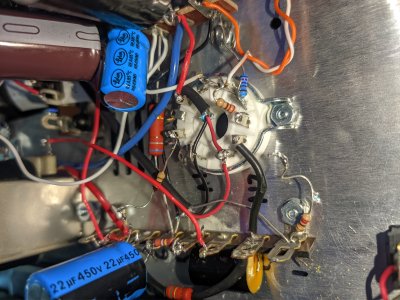Let's start with the left grounding tab reading OL.
The left input jack/pot grounds all wire to 23, which you have with an OL, but it should be grounded. 23 attaches to 26, and your 26 is also OL, but should be grounded. 36 connects to 26, which both should also be grounded, but are not. That's one entire side of the amp not grounded. 36 is also basically the output of the power supply, so it's a good idea not to turn the amp on until this is resolved.
On the other channel, the ground leaving 36 goes to 12, which also isn't grounded. 12 should go to 5 with a black wire, and that wire doesn't look well connected at 5. In that area be sure the drain wire on the shielded twisted pair wire is pushed down close to the chassis and the foil in that cable doesn't touch anything other than the chassis if necessary.
Terminal 12 is wired to terminal 9, and you skipped that step. I would imagine if you install the wire that should be there, things will start looking better.

